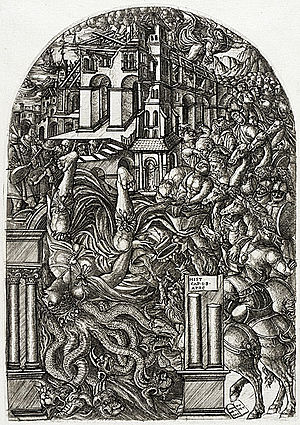- Horror vacui
-
 Many paintings by Outsider Artist Adolf Wölfli contain space filled with writing or musical notation
Many paintings by Outsider Artist Adolf Wölfli contain space filled with writing or musical notation
 The Fall of Babylon, engraving by Jean Duvet from the Apocalypse series, circa 1555, plate size: 11 7/8 x 8 3/8 in.
The Fall of Babylon, engraving by Jean Duvet from the Apocalypse series, circa 1555, plate size: 11 7/8 x 8 3/8 in.
In visual art, horror vacui (English pronunciation: /ˈhɔrər ˈvɑːkjuːaɪ/; from Latin "fear of empty space", which might be represented by white spots; also cenophobia, pronounced /sɛnəˈfoʊbɪə/, from Greek "fear of the empty"[1]) is the filling of the entire surface of an artwork with detail.
The term is associated with the Italian critic and scholar Mario Praz, who used it to describe the suffocating atmosphere and clutter of interior design in the Victorian age. Older, and more artistically successful examples can be seen on Migration period art objects like the carpet pages of Insular illuminated manuscripts such as the Book of Kells. Moving east, this feeling of meticulously filling empty spaces permeates Arabesque Islamic art from ancient times to the present. Another example comes from ancient Greece during the Geometric Age (1100 - 900 BCE), when horror vacui was considered a stylistic element of all art. The mature work of the French Renaissance engraver Jean Duvet consistently exhibits horror vacui.
Some examples of horror vacui in art come from, or are influenced by, the mentally unstable and inmates of psychiatric hospitals, such as Richard Dadd in the 19th century, and many modern examples fall under the category of Outsider Art. Horror vacui may have also had an impact, consciously or unconsciously, on graphic design by artists like David Carson or Vaughan Oliver, and in the underground comix movement in the work of S. Clay Wilson, Robert Crumb, Robert Williams, and on later comic artists such as Mark Beyer. The paintings of Williams, Faris Badwan, Joe Coleman and Todd Schorr are further examples of horror vacui in the modern Lowbrow art movement.
The entheogen-inspired visionary art of certain indigenous peoples, such as the Huichol yarn paintings and the ayahuasca-inspired art of Pablo Amaringo, often exhibits this style, as does the psychedelic art movement of the 1960s counterculture. Sometimes the patterned art in clothing of indigenous peoples of Middle and South America exhibits horror vacui. For example the geometric molas of Kuna people and the traditional clothing on Shipibo-Conibo people.
The artwork in the Where's Waldo? series of children's books is a commonly-known example of horror vacui, as are many of the small books written or illustrated by the macabre imagination of Edward Gorey.
The Tingatinga painting style of Dar es Salaam in Tanzania is a contemporary example of horror vacui. Other African artists such as Malangatana of Mozambique (Malangatana Ngwenya) also fill the canvas in this way.
It may also be used in reference to the fear of the ancient Romans in stepping beyond their own boundaries.
The arrangement of Ancient Egyptian hieroglyphs suggests an abhorrence of empty space. Signs are repeated or phonetic complements added to prevent gaps.
See also
References
- ^ Lesley Brown: The New Shorter Oxford English Dictionary. Vol. 1: A−M. Clarendon Press, Oxford 1993, p.360
Categories:
Wikimedia Foundation. 2010.
